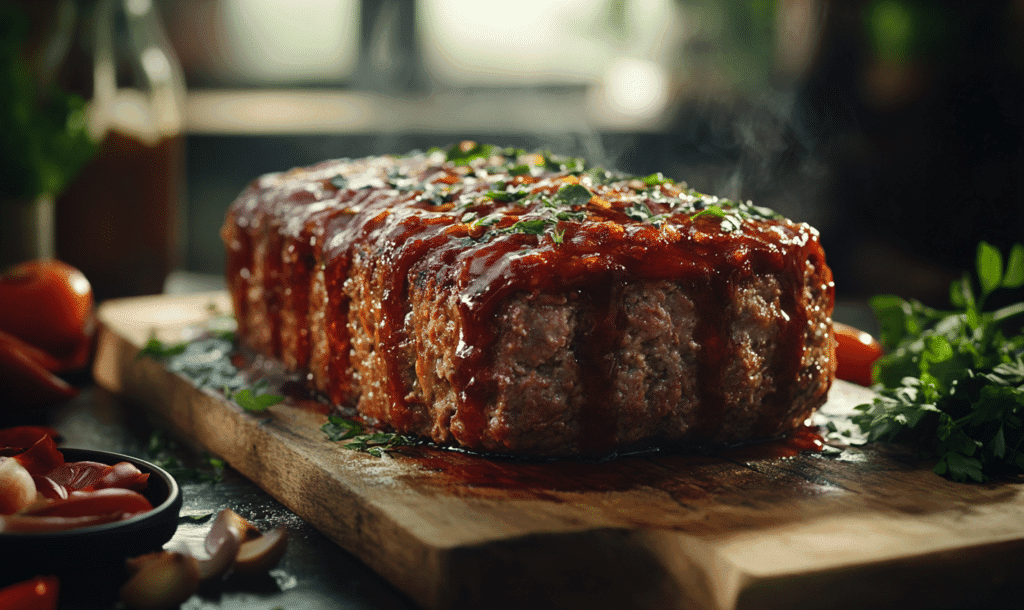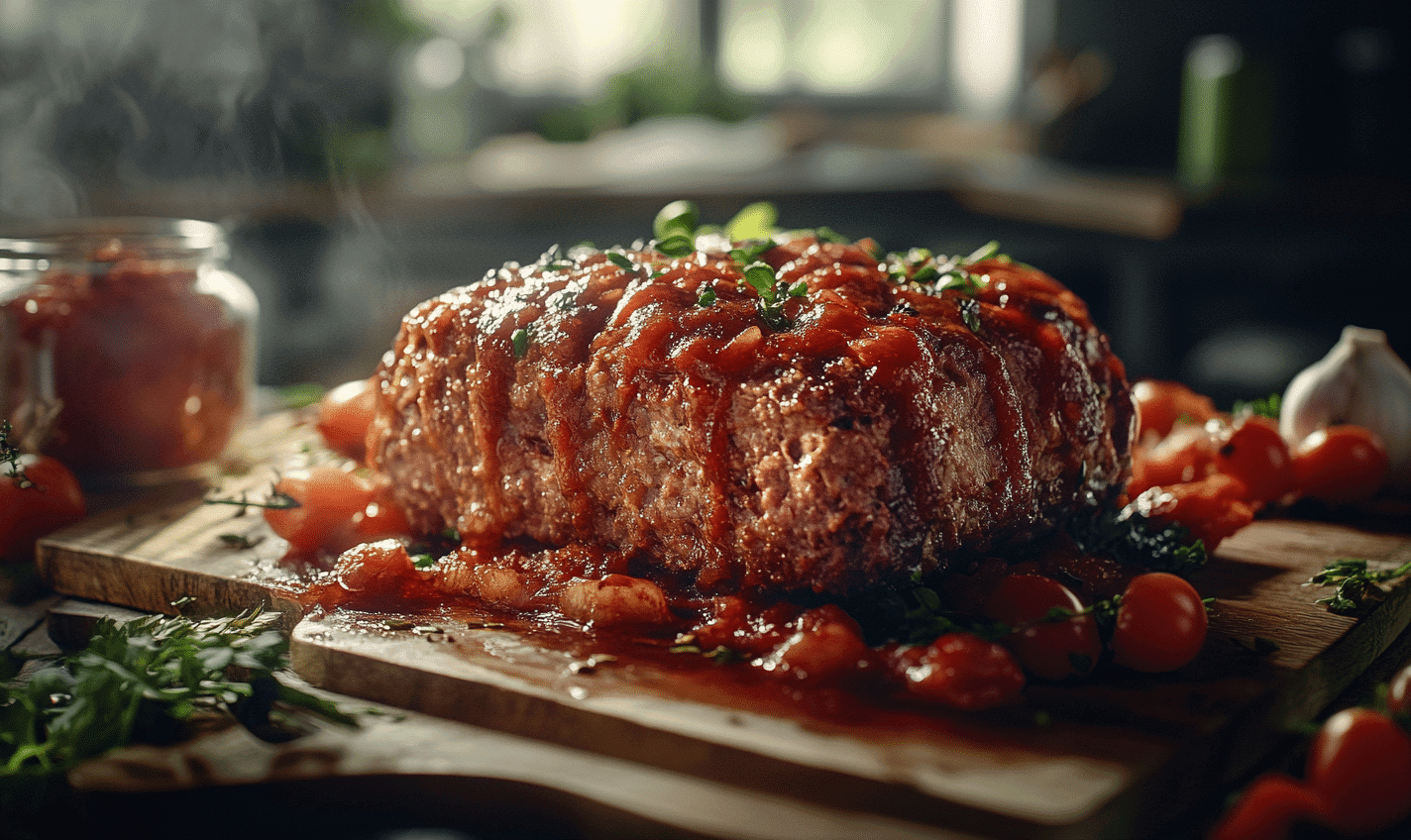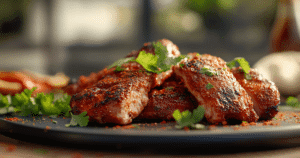Jump to:
Estimated reading time: 13 minutes
Table of contents
Introduction to Milk versus water meatloaf
When discussing why milk is often preferred over water in meatloaf recipes, it’s important to consider how each ingredient impacts the texture and flavor of the dish. While water can be used in a pinch, milk adds richness and moisture, ensuring a tender and flavorful meatloaf. Understanding how temperature also plays a crucial role in cooking meatloaf, as discussed in this guide on Temperature Pellet Grill Meatloaf can further enhance your cooking technique, ensuring your meatloaf turns out perfectly every time.
Meatloaf is a classic comfort food that many families love. While the basic recipe is simple, there are many ways to make it better. One common question is why recipes often call for milk instead of water. Understanding why milk is used can help you make a more flavorful, moist, and tender meatloaf.
In this guide, we’ll explore why milk is used in meatloaf, how it compares to water, the benefits it brings to the dish, and alternatives for those with dietary needs. We’ll also look at the history of meatloaf and offer tips to make sure your meatloaf turns out perfectly every time.
The Role of Liquid in Meatloaf
Understanding the Basics
Meatloaf is a mix of ground meat, binders, seasonings, and liquid. The liquid is crucial because it softens the binders, like breadcrumbs or oatmeal, which help hold the meatloaf together. Without enough moisture, the meatloaf can turn out dry, dense, and crumbly.
Common liquids in meatloaf recipes include milk, water, broth, and sometimes tomato juice. Each liquid affects the texture, flavor, and moisture of the final dish differently.
Why Liquid is Essential
The main reason to add liquid to meatloaf is to soften the breadcrumbs or other fillers. When the breadcrumbs soak up the liquid, they swell and become soft, helping to keep the meatloaf tender and juicy. This also helps the meatloaf hold its shape and keeps it from falling apart when sliced.
Additionally, the liquid helps spread the seasonings evenly throughout the meatloaf, ensuring every bite is flavorful. The choice of liquid greatly affects the taste and texture of the meatloaf, making it an important part of the recipe.
Why Milk versus water meatloaf?
The Science Behind Milk in Meatloaf
Using milk instead of water in meatloaf isn’t just about adding moisture—it’s about enhancing flavor, texture, and the overall eating experience. Milk adds both liquid and fat, which play key roles in cooking.
- Moisture Retention: Milk contains proteins and fats that help keep moisture in the meatloaf. The proteins in milk form a gel-like structure during cooking that traps water and fat, keeping the meatloaf moist. Water lacks these proteins and fats, so it doesn’t retain moisture as well.
- Tenderizing Effect: The natural acid in milk acts as a tenderizer for the meat. It gently breaks down the muscle fibers in the ground meat, making the texture softer. Water doesn’t have the same acidic properties, so it doesn’t tenderize the meat in the same way.
- Flavor Enhancement: Milk has a mild, creamy flavor that boosts the overall taste of the meatloaf. It blends well with the other ingredients, creating a richer and more balanced flavor. Water, being flavorless, doesn’t add to the flavor, making the meatloaf taste less rich.
- Binding and Structure: Milk helps the breadcrumbs or other fillers in the meatloaf bind the mixture together more effectively. The fat in milk helps create a smooth texture that is both soft and easy to slice. Without this fat, water can make the mixture more likely to crumble.
The Difference in Texture
When milk is used in meatloaf, the texture becomes smoother and more cohesive. The fat in milk acts as a lubricant between the meat and the fillers, resulting in a melt-in-your-mouth texture. On the other hand, using water can lead to a grainier, less tender meatloaf that lacks the same richness.
This difference in texture is especially noticeable in meatloaf that is baked for longer periods. The fat and proteins in milk help create a slightly crispy, caramelized crust on the outside while keeping the inside moist. Water, without these properties, can cause the meatloaf to dry out more quickly, especially at higher cooking temperatures.
Enhanced Browning and Caramelization
Milk contains natural sugars, like lactose, which help brown the meatloaf during cooking. This browning adds flavor and gives the meatloaf a slightly crispy crust. Water, lacking sugars, doesn’t contribute to this browning, so the meatloaf may have a paler, less flavorful crust compared to one made with milk. The browning provided by milk not only improves the look of the meatloaf but also enhances its flavor.
Milk versus water meatloaf: Nutritional Benefits of Using Milk
Rich in Nutrients
Milk is a nutritious ingredient that adds more than just moisture to meatloaf. It contains several essential nutrients, including:
- Calcium: Important for strong bones and teeth, calcium also helps muscles and nerves work properly.
- Vitamin D: Helps the body absorb calcium and supports the immune system.
- Protein: Helps build and repair muscles and tissues.
- B Vitamins: Including B12 and riboflavin, which are important for energy and maintaining healthy skin and nerves.
- Healthy Fats: Depending on the type of milk used, it can contribute to the healthy fats needed for overall health.
These nutrients not only improve the nutritional value of the meatloaf but also make the meal more satisfying and balanced.
Comparing Milk and Water
When comparing the nutritional value of milk and water, the differences are clear. Water, while essential for hydration, provides no calories, fat, protein, vitamins, or minerals. Milk, on the other hand, adds calories from fats and carbohydrates, as well as protein and essential vitamins and minerals, making the meal more balanced and nourishing.
Impact on Caloric Content
It’s important to note that using milk in meatloaf will increase the overall calorie count of the dish due to the fat and carbohydrates in milk. However, this can be a good thing for those looking to create a more filling and satisfying meal. For those who are watching their calorie intake, using lower-fat milk options, such as skim or 1% milk, can reduce the calorie content while still providing many of the benefits.

Alternatives to Milk in Meatloaf
Dairy-Free Options
For those who are lactose intolerant or following a dairy-free diet, there are several alternatives to milk that can be used in meatloaf. Each of these substitutes offers different benefits, and some may even bring their unique flavors to the dish.
Plant-Based Milk
- Almond Milk: Almond milk is a popular dairy-free alternative that works well in meatloaf. It has a slightly nutty flavor, which can add an interesting twist to the dish. However, it is lower in fat compared to cow’s milk, so the meatloaf may not be as rich.
- Soy Milk: Soy milk is another good option. It has more protein than most other plant-based milks, making it a closer substitute for cow’s milk in terms of texture and structure. Soy milk also has a neutral flavor, so it won’t change the taste of the meatloaf much.
- Oat Milk: Oat milk has a creamy texture and slightly sweet flavor, making it a good replacement for milk in meatloaf. It also has more carbohydrates, which can help with browning and caramelization during cooking.
- Coconut Milk: For a more unique flavor, coconut milk can be used. It’s rich and creamy, with a distinct coconut flavor that pairs well with certain seasonings. However, it’s important to use the lighter, drinkable version of coconut milk rather than the thick, canned variety.
Broth or Stock
- Chicken or Beef Broth: Broth or stock can be used in place of milk for a savory alternative. Broth adds flavor and moisture but lacks the fat content that milk provides. This can result in a slightly less tender meatloaf, but it will still be flavorful. Using broth can also enhance the meaty taste of the dish, making it a good option for those who prefer a stronger flavor.
- Vegetable Broth: For a vegetarian option, vegetable broth is a good choice. It provides moisture and a subtle flavor that won’t overpower the other ingredients. Like other broths, it lacks the fat content of milk, so the texture may be different, but it will still hold together well.
Water with Additions
If you prefer to use water but still want to achieve a similar effect to milk, consider adding a few ingredients to mimic the properties of milk:
- Butter or Oil: Adding a tablespoon of melted butter or oil to the water can introduce the fat that is missing, helping to retain moisture and improve the texture.
- Egg Yolk: Mixing an extra egg yolk with the water can help create a richer texture, as the yolk adds both fat and protein.
- Sour Cream or Yogurt: A spoonful of sour cream or plain yogurt mixed with water can replicate the creamy texture of milk. These ingredients also contribute a tangy flavor that can enhance the overall taste of the meatloaf.
The Role of Non-Dairy Creamers
Non-dairy creamers can also be used as a substitute for milk in meatloaf. They are available in various flavors, including plain, vanilla, and hazelnut. If you choose to use a non-dairy creamer, opt for an unsweetened variety to avoid adding unwanted sweetness to your meatloaf.
While non-dairy creamers can mimic the texture and richness of milk, they often contain additives and artificial ingredients. Therefore, they may not be the best choice for those looking for a more natural or whole-food approach to cooking.
Tips for Perfecting Your Meatloaf with Milk
Choosing the Right Milk
The type of milk you use in your meatloaf can affect the final dish:
- Whole Milk: Provides the richest flavor and texture, thanks to its higher fat content. It’s the best choice if you want a traditional, hearty meatloaf.
- 2% Milk: A good middle ground, offering some of the richness of whole milk but with fewer calories.
- Skim Milk: Works well if you’re looking to reduce fat and calories, though the meatloaf may be slightly less rich.
- Buttermilk: Adds a tangy flavor and tender texture due to its higher acidity. Buttermilk is an excellent choice if you want to add a little extra depth of flavor to your meatloaf.
Mixing Ingredients
When adding milk to your meatloaf mixture, follow these tips to ensure the best results:
- Soak the Breadcrumbs: Start by soaking the breadcrumbs in milk for a few minutes before mixing them with the other ingredients. This allows the breadcrumbs to fully absorb the liquid, ensuring they are soft and ready to bind the meatloaf together.
- Avoid Overmixing: Once you add the milk-soaked breadcrumbs to the meat, mix the ingredients just until combined. Overmixing can lead to a dense, tough meatloaf.
- Adjust the Quantity: If your mixture seems too wet after adding milk, you can add more breadcrumbs or a small amount of flour to absorb the excess moisture. If it’s too dry, add a little more milk until the mixture reaches the desired consistency.
Enhancing Flavor
To further enhance the flavor of your meatloaf, consider adding some of the following ingredients:
- Grated Cheese: Adding grated cheese to the meat mixture can boost the richness and flavor. Cheese pairs particularly well with milk and helps create a creamier texture.
- Herbs and Spices: Fresh or dried herbs like parsley, thyme, and oregano can add complexity to the flavor profile. Spices like garlic powder, onion powder, and paprika complement the milk and add depth to the taste.
- Mustard or Worcestershire Sauce: A small amount of mustard or Worcestershire sauce can add a tangy, umami flavor that enhances the richness provided by the milk.
Cooking Techniques
To achieve the perfect meatloaf, follow these cooking tips:
- Baking Temperature: Bake the meatloaf at 350°F (175°C) for about 60-75 minutes, or until the internal temperature reaches 160°F (71°C). This moderate temperature allows the meatloaf to cook evenly without drying out.
- Covering with Foil: If you notice the top of the meatloaf browning too quickly, cover it with aluminum foil to prevent it from burning while the inside continues to cook.
- Resting Time: After baking, let the meatloaf rest for 10-15 minutes before slicing. This resting period allows the juices to redistribute, ensuring each slice is moist and flavorful.
The History of Milk in Meatloaf
Traditional Practices
The use of milk in meatloaf is rooted in traditional cooking practices that date back centuries. In the past, milk was often used in various meat dishes to extend the ingredients and make the meal more filling. This practice was particularly common during times of scarcity when stretching the meat supply was essential.
Over time, cooks discovered that milk not only helped to bind the ingredients but also improved the texture and flavor of the dish. As a result, milk became a staple ingredient in many meatloaf recipes, especially in the United States and Europe.
Cultural Variations
While milk is a common ingredient in American and European meatloaf recipes, other cultures have their variations:
- Italian Meatloaf (Polpettone): Often includes milk-soaked breadcrumbs along with Parmesan cheese, garlic, and herbs.
- German Meatloaf (Falscher Hase): May use a combination of milk and broth, along with eggs and breadcrumbs, to create a moist and flavorful loaf.
- Swedish Meatloaf (Köttfärslimpa): Typically includes milk or cream, along with potatoes and onions, to create a tender and rich meatloaf.
These cultural variations highlight the versatility of meatloaf and the importance of milk in creating a delicious, satisfying dish.
Frequently Asked Questions: Milk versus water meatloaf
Should I use milk or water in meatloaf?
Milk is generally preferred over water in meatloaf because it adds extra moisture, richness, and flavor. Milk helps soften the breadcrumbs, creating a tender texture and preventing the meatloaf from drying out. Water can be used in a pinch, but it lacks the richness that milk provides.
How does milk improve meatloaf texture?
Milk hydrates the breadcrumbs, allowing them to swell and create a softer, juicier texture in the meatloaf. The fat and proteins in milk add richness and help make the meatloaf more tender, contributing to a better overall mouthfeel.
Can I substitute water for milk in meatloaf?
Yes, you can substitute water if you don’t have milk. However, consider adding a small amount of melted butter or oil to the water (about 1 tablespoon per cup of water) to help mimic the richness of milk. Broth is another good substitute that adds extra flavor.
What about using other liquids like broth or plant-based milk?
Yes, broth (chicken, beef, or vegetable) can add flavor while keeping the meatloaf moist. Plant-based milk (such as almond, soy, or oat milk) can also work well, especially if unsweetened and unflavored. These options are suitable for dairy-free diets and add more flavor than water alone.
Conclusion
When it comes to making meatloaf, the choice between milk and water can significantly affect the outcome of your dish. Milk not only adds moisture but also enhances the overall flavor, resulting in a tender, rich meatloaf. For those curious about alternatives or the science behind using milk, you can explore discussions on What will happen if you don’t use milk in meatloaf ? and discover ways . Additionally, if you’re looking for good recipes for cooking meatloaf without milk, there are plenty of alternatives to consider. Each option provides unique insights that might change how you prepare your next meatloaf.
Using milk instead of water in meatloaf is more than just a tradition—it’s a technique that enhances the flavor, texture, and overall quality of the dish. The proteins, fats, and sugars in milk contribute to a tender, moist meatloaf with a rich, creamy flavor that simply can’t be achieved with water alone. While there are alternatives for those with dietary restrictions, milk remains the gold standard for achieving the best results in meatloaf.
By understanding the role of milk in meatloaf and following the tips outlined in this guide, you can create a meatloaf that’s not only delicious but also perfectly moist and tender. Whether you stick with traditional milk or explore dairy-free alternatives, your meatloaf is sure to be a hit at the dinner table.






